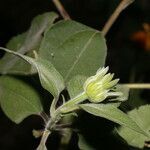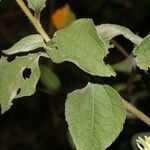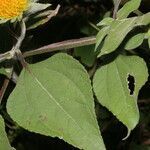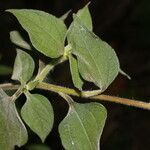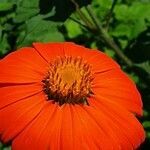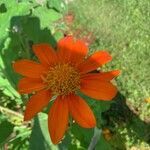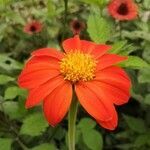Annual herb 2–3 m high; stem reddish purple, striate, pubescent, glabrescent. Leaves with petiole 2–5 cm long; lamina ovate to triangular in outline, (3–) 5–11 (27) cm long, (1.5–) 2–13 (–20) cm wide, entire or sometimes 3–5-lobed, shortly toothed, acuminate, coarsely scabrous above; base decurrent to petiole. Capitula 3–4 (–9) cm diam. (including rays), on peduncles 10–20 (–30) cm long; paleae c. 1.5 cm long; involucral bracts ± equal, linear to lanceolate, 2-or 3-seriate, obscurely striate, softly pilose abaxially; inner bracts long-tapering to apex. Ray floret ligules 12–30 mm long, orange. Disc florets numerous, c. 10 mm long; outer surface pilose, orange to yellow. Achenes 6–8 mm long, black or mottled, appressed-pilose. Pappus of hard, white, fused, erose scales and 2 ± equal awns 3–5 mm long.
Branching annual herb to about 2 m. Leaves alternate, up to c. 15 x 10 cm, more or less ovate in outline, often deeply 3-lobed, scabrid-pubescent, base cordate-cuneate, decurrent on the petiole, petiole up to c. 7 cm long. Heads terminating the main and side branches, very large and showy, up to 9 cm across the expanded rays, solitary on peduncles up to 30 cm long and much swollen below the heads. Involucral bracts biseriate, oblong-lanceolate, acute, pubescent. Rays bright orange-red above, golden yellow below, disc orange-red. Achenes c. 8 mm long, narrowly oblong-obovate, somewhat compressed, appressed-hairy. Pappus of several short broad scales and 2 lateral awns, one much shorter than the other.
Annuals, mostly 100–200(–400) cm. Leaves: petioles 3–8 cm; blades ± deltate to pentagonal, 7–38 × 7–30 cm, sometimes 3-or 5-lobed, abaxial faces glabrous or soft-pubescent. Peduncles 11–27 cm. Phyllaries 14–21 in (2–)3 series, lanceolate to linear; outer 17–30 × 4–7.5 mm, apices acute, abaxial faces usually densely puberulent; inner 16–28 × 5–8 mm, apices rounded to acute, abaxial faces usually densely puberulent. Paleae 11.5–15 × 2–3 mm, mucros 2.5–5.5 mm. Ray florets 8–13; corollas usually orange, sometimes yellow, laminae oval to oblong, 20–33 × 6–17 mm. Disc florets 60–90. Cypselae 5–7. 2n = 34.
This annual has been cultivated in Kenya: Nairobi Arboretum, Feb. 1952, Williams Sangai 346! & Kikuyu, Njogu Inn, July 1953, Verdcourt 990! It does not seem to become naturalized as it does in the Flora Zambesiaca area, where it is a common weed of roadsides and disturbed ground. Possibly the T. speciosa mentioned in U.O.P.Z.: 473 (1949) is this taxon.
Annual herb, up to 2 m high. Involucre biseriate, bracts herbaceous, acute. Flowers with rays bright orange-red above, golden yellow below, disc orange-red.
